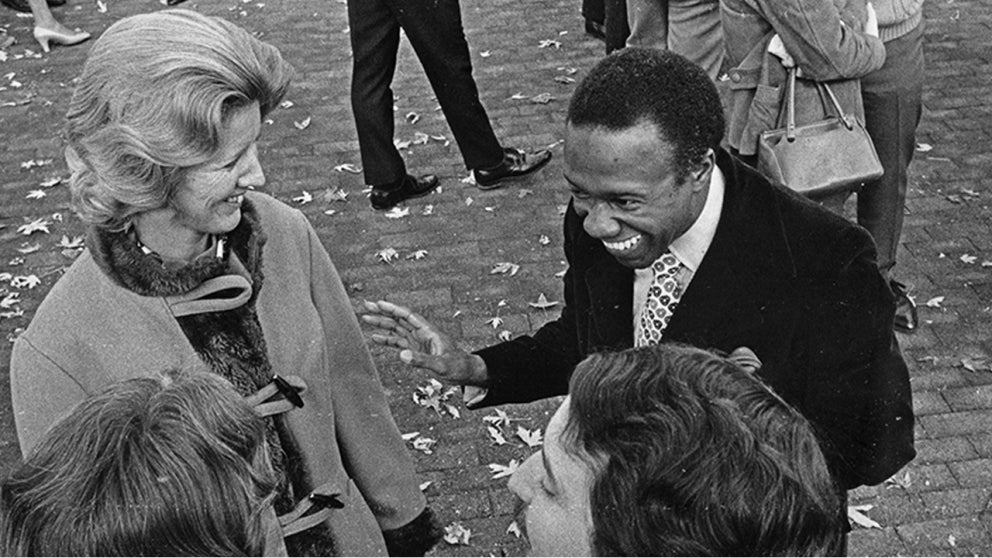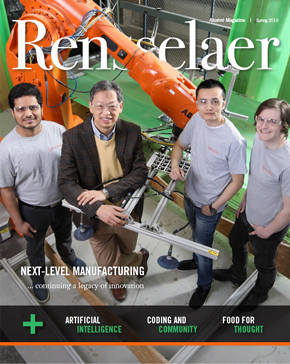
From the Archives: Chapel and Cultural Center Celebrates 50 Years

By Rick Hartt ’70
October 2018 marked the 50th anniversary of the Rensselaer Newman Foundation’s Chapel and Cultural Center, known by most as the C+CC. It was the vision of then Catholic Chaplain Thomas Phelan, who only five years later would become dean of the School of Humanities and Social Sciences. Supported by a board of trustees that included Professor Steve Wiberley ’48 and many Rensselaer and local community leaders, the C+CC was dedicated in October 1968. The Foundation’s charter by the New York State Education Department as an educational organization has provided great opportunity for the C+CC to be more than a building.
Architect Peter Levatich ’55 designed an energy-efficient building ahead of its time. It immediately garnered attention and recognition both for its outstanding design and unique blend of being a center for religion, education, and the arts. By February 1969, multiple national and international publications had written articles on the C+CC, including feature articles in Progressive Architecture and The New York Times. An article by Franklin Whitehouse published in The New York Times on Dec. 8, 1968, lauded the utilitarian simplicity of its design. This unique marriage of architecture and purpose would lead to the C+CC receiving many awards over its 50 years. On Feb. 22, 2011, the United States Department of the Interior recognized the C+CC’s architectural and social significance by adding it to the National Register of Historic Places, making it the “youngest” structure on the registry.
The impact on the campus and local communities was immediately evident. The dedication celebration was highlighted by not only New York City Ballet’s principal dancer Melissa Hayden and contemporary liturgical music by Father Clarence Rivers, but also student performances including the RPI Players.
In 1970, the C+CC provided a “safe space” for students to discuss and debate what would have great impact on Rensselaer, such as “The Requisites for a Technological University” and national and international issues such as the Vietnam War and a student strike at Rensselaer. A home for discourse between the community and campus continues to this day with the McCarthy-Wiberley Town and Gown Breakfast.
The education program morphed over the years from the “Free School” that offered classes such as Tai Chi, discussion groups, and craft classes to the current Lenten Speaker Series, always exploring the intersections of culture and religion. Visual arts exhibitions have also been important in exploring how arts and religion are inextricably linked, reflecting the culture of the time.
The performing arts are always at the C+CC’s core. In the early years, professional performances by groups such as the innovative dance and movement of Pilobolus, the Warsaw Mime Theater, and the Dinizulu Dance Company were presented to the campus community through the Festival of Religion and the Arts. Adapting to today’s needs of Rensselaer, the arts program of 2018 now has a student performance focus with many of the Rensselaer student vocal groups using the C+CC as their performance home. Concerts by a cappella groups are regularly a highlight for the campus community.
Under the leadership of Rensselaer coordinator of religious affairs and Catholic Chaplain Father Ed Kacerguis, the C+CC continues to be true to its purpose. It is a place of worship as the home of the Christ Sun of Justice Parish, personal reflection, education, the arts, and community-building. The success of the first 50 years is a prelude to the next 50 years, demonstrating how the C+CC, its people, and programs can create a better experience for students, the campus, and the local community.















